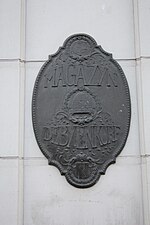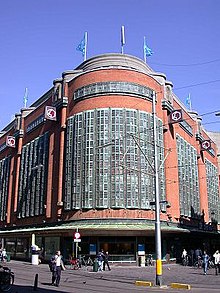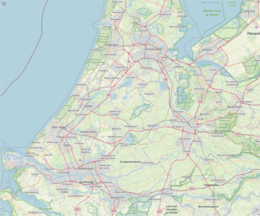
The history of the Jews in the Netherlands largely dates to the late 16th century and 17th century, when Sephardic Jews from Portugal and Spain began to settle in Amsterdam and a few other Dutch cities, because the Netherlands was an unusual center of religious tolerance. Since Portuguese Jews had not lived under rabbinic authority for decades, the first generation of those embracing their ancestral religion had to be formally instructed in Jewish belief and practice. This contrasts with Ashkenazi Jews from central Europe, who, although persecuted, lived in organized communities. Seventeenth-century Amsterdam was referred to as the "Dutch Jerusalem" for its importance as a center of Jewish life. In the mid 17th century, Ashkenazi Jews from central and eastern Europe migrated. Both groups migrated for reasons of religious liberty, to escape persecution, now able to live openly as Jews in separate organized, autonomous Jewish communities under rabbinic authority. They were also drawn by the economic opportunities in the Netherlands, a major hub in world trade.

There are 137 movie theaters and 31 arthouse cinemas in the Netherlands, with a total of ca. 675 screens, in addition to 79 small arthouse cinemas and a number of adult movie theaters. The main movie theater chains in the Netherlands are Pathé, VUE and Kinepolis.

The Nederlands Verbond voor Progressief Jodendom is the umbrella organisation for Progressive Jews in the Netherlands, and is affiliated to the World Union for Progressive Judaism. It was founded in 1931.

Vroom & Dreesmann (V&D) was a Dutch chain of department stores founded in 1887. It was declared bankrupt on 31 December 2015, although its branches were still in operation until 15 February 2016. On 16 February 2016, it was announced that takeover negotiations had not led to an agreement, ultimately resulting in the company's demise.
The 1996/1997 season in Dutch football was the 41st professional season in the Eredivisie, with PSV Eindhoven winning the title and Roda JC claiming the Dutch National Cup.

Maxeda is a Dutch retail company owned by American investment firm Kohlberg Kravis Roberts & Co. (KKR) which is currently a market leader in the DIY retailing in The Netherlands, Belgium and Luxembourg. When Maxeda acquired Vendex KBB, Maxeda owned the three most prominent Dutch department stores: Vroom & Dreesmann and De Bijenkorf, both sold in 2010, and HEMA, sold in 2007.
The Museum Card, also known as the Museumkaart in Dutch, is a personal card that grants free entry to approximately 400 museums in the Netherlands for one year. It is available for purchase at many of the larger participating museums or online, with a temporary card issued when purchased from the museum. While most museums offer free entry to Museum Card holders, some museums may charge an additional fee for special exhibitions, but not for general collections.

Den Haag HS, an abbreviation of the original name Den Haag Hollands Spoor, is the oldest train station in The Hague, South Holland, Netherlands, located on the Amsterdam–Haarlem–Rotterdam railway. It is the second main station in The Hague and, unlike The Hague Central Station, it is not a terminus station. The name of the station is derived from the former Hollandsche IJzeren Spoorweg-Maatschappij (HIJSM) which was the first Dutch railway company.

Jo Coenen is a Dutch architect and urban planner. He studied architecture at the Eindhoven University of Technology, and later held professorships at TU Karlsruhe, Eindhoven University of Technology and Delft University of Technology.
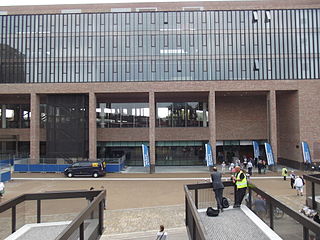
Breda railway station is a railway station in Breda in North Brabant, Netherlands. It is situated on the Breda–Rotterdam railway, the Roosendaal–Breda railway and the Breda–Eindhoven railway.

Music venues in the Netherlands are a vivid part of the social cultural environment of the country.
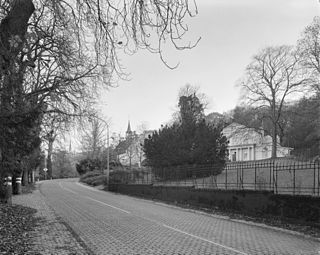
Rijksstraatweg or simply Straatweg was the term for paved roads of interregional significance in the Netherlands in the 19th and early 20th centuries. These roads were built by the national government, and formed the country's first centrally planned highway network. They received route numbers, eventually resulting in a nationwide network of 82 highways. It formed the basis for today's system of nationally controlled roads, the Netherlands' main highway grid.
The Dutch Israelite Religious Community of The Hague is the Ashkenazi Orthodox Jewish community in The Hague and is a member of the Nederlands-Israëlitisch Kerkgenootschap (NIK).

Hendrik Albertus van den Eijnde or van den Eynde was a Dutch sculptor. His work was part of the sculpture event in the art competition at the 1936 Summer Olympics.
Max Reisel was a Dutch semiticist and a teacher at the Montessori Lyceum Rotterdam. He strove in the dissemination of knowledge about Judaism in general and Hebrew language in particular. He played an important role in the field of education in the Netherlands.

Galeries Modernes was a department store chain in the Netherlands in the 20th century, with roots in the earlier company Grand Bazar Français. The last branches were closed in 1984.
